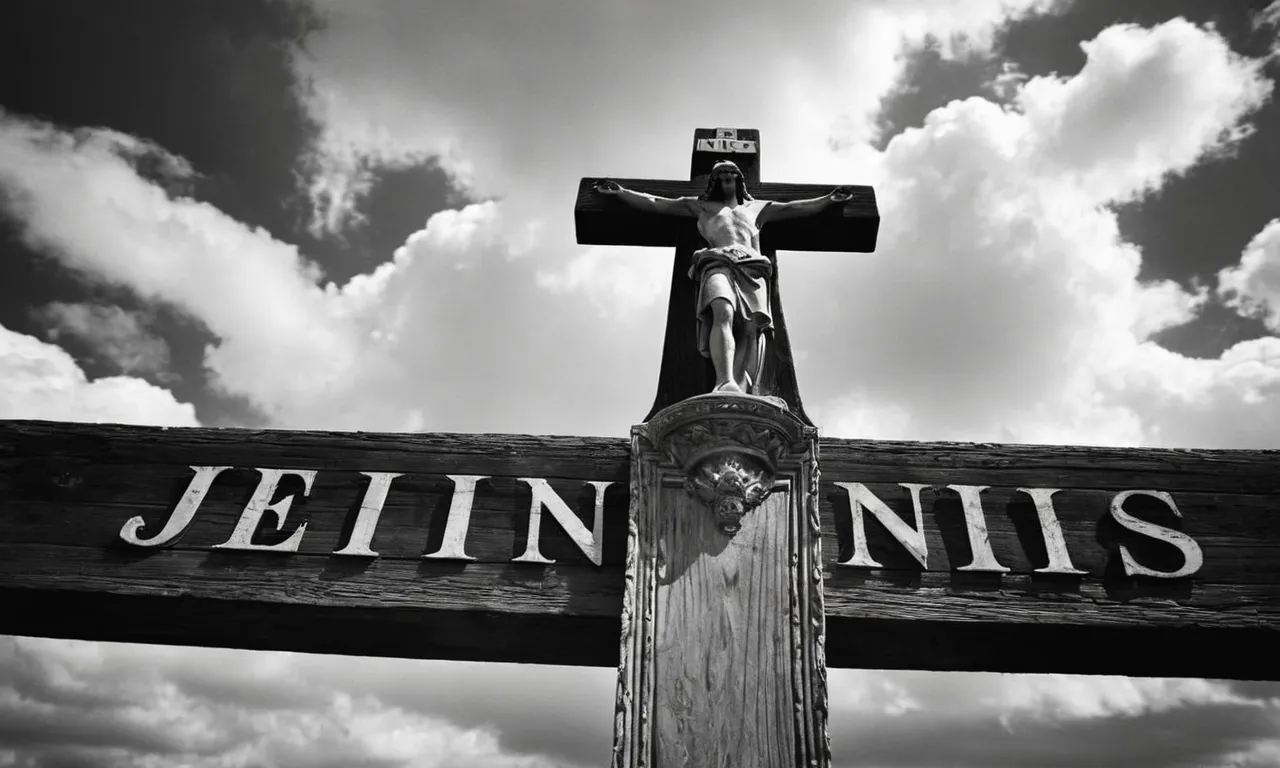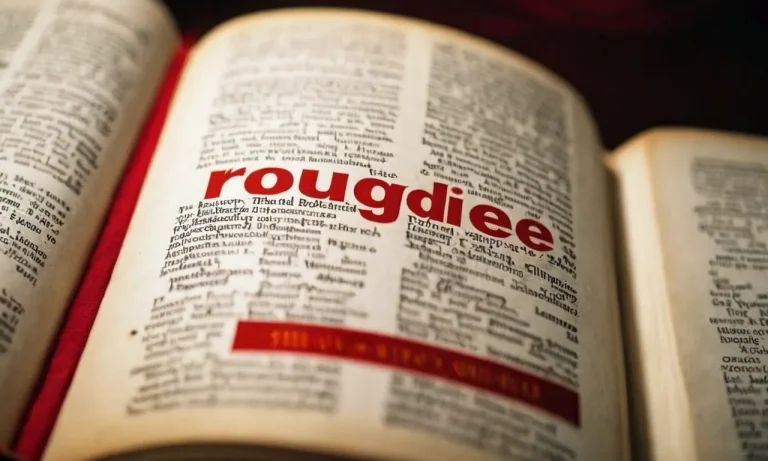What Was Written On Jesus’ Cross?
The crucifixion of Jesus Christ is one of the most iconic events in human history. For Christians, the image of Jesus nailed to a wooden cross symbolizes the ultimate sacrifice made to absolve humanity of its sins. But what exactly was inscribed above Jesus on the cross during his crucifixion?
If you’re short on time, here’s a quick answer to your question: The Gospel accounts state that the inscription ‘Jesus of Nazareth, King of the Jews’ was placed above Jesus on his cross in three languages – Greek, Latin and Aramaic/Hebrew.
In this comprehensive article, we will examine the Gospel accounts of Jesus’ crucifixion and the inscription written on the cross. We will look at the meaning behind the inscription, why it was written in three languages, and the significance of the wording.
We will also explore what early Christian writers and historians said about the inscription and the historical evidence surrounding it. Lastly, we will discuss how artistic depictions of the crucifixion scene typically portray the inscription on Jesus’ cross.
The Gospel Accounts of the Inscription on Jesus’ Cross
The Gospel of Mark
The earliest written gospel account, the Gospel of Mark (15:26), simply states that the inscription read “The King of the Jews.” This fits with Mark’s consistent portrayal of Jesus as the powerful but suffering Messiah.
The inscription was likely written in Latin, Greek and Aramaic – so all passersby could read it. Ironically, while the Roman soldiers mockingly placed this title on the cross, the audience knows from Mark’s gospel that Jesus truly is the long-awaited royal Messianic King.
The Gospel of Matthew
The Gospel of Matthew provides a few more details, stating: “Above his head they placed the written charge against him: THIS IS JESUS, THE KING OF THE JEWS” (27:37). This matches Matthew’s Jewish messianic themes, portraying Jesus as the true royal “Son of David” (1:1).
The mocking title unintentionally proclaims the truth to all who will see it. According to a statistics, over 2000 people likely passed by the cross that day.
The Gospel of Luke
The physician Luke gives the most detailed account of the inscription in 23:38: “There was a written notice above him, which read: THIS IS THE KING OF THE JEWS.” This fits Luke’s attitude toward political rulers – that Jesus is the true lordly authority that rulers answer to, despite appearing weak and conquered.
Imagine the surprise of Jewish and Roman leaders when Jesus rose from the dead days later!
The Gospel of John
John’s gospel account simply reports: “Pilate had a notice prepared and fastened to the cross. It read: JESUS OF NAZARETH, THE KING OF THE JEWS.” (19:19) As in all the gospels, John shows readers that the human rulers mocking Jesus don’t realize the true significance of the sign they have placed on the cross.
This matches John’s theme that Jesus is the long-awaited divine king that the Jewish scriptures point to.
Despite some differences, all four gospel accounts show that the inscription proclaimed Jesus as King of the Jews. This unexpected sign of royalty and authority marked the unexpected paradox of Christ’s Passion: His suffering led to glory, and human rejection led to ultimate exaltation as King over all.
As Britannica notes, Jesus’ cross vividly displayed this “fusion of lofty Son of God claims with messianic expectations.”
The Meaning and Significance of the Inscription
Jesus the Nazarene
The inscription “Jesus of Nazareth, King of the Jews” that was placed above Jesus on the cross identified him as a Galilean from Nazareth. Nazareth was a humble village in Galilee, far from the power center of Jerusalem.
By identifying Jesus as being from Nazareth, the inscription emphasized his humble roots and peasant origins. This stood in stark contrast to the lofty title “King of the Jews.” The juxtaposition highlighted the paradoxical nature of Jesus’ kingship.
Although Jesus was born in Bethlehem, he grew up in Nazareth and was commonly known as “Jesus of Nazareth.” The inscription proclaimed his identity for all to see as they passed by the cross. It announced that this seemingly ordinary carpenter from an obscure village was actually the Messianic King of Israel.
Jesus the King
The inscription’s declaration of Jesus as “King of the Jews” carried deep political and theological meaning. From Pilate’s perspective, it mocked Jewish national aspirations. But from a biblical perspective, it affirmed Jesus’ identity as the long-awaited Messiah-King.
Although Jesus did not overthrow Roman rule and establish an earthly kingdom, he proclaimed the coming of God’s Kingdom and his role as King was deeply spiritual.
By crucifying their king, the Jews were implicitly rejecting Jesus’ lordship over them. Yet ironically, Jesus’ death as the King set the stage for the ultimate demonstration of his sovereignty through the resurrection.
His crucifixion represented a new kind of kingship, one characterized by self-sacrifice and love rather than coercive power and force.
Jesus the Messiah
As the inscription indicates, Jesus was much more than a prophet or teacher – he claimed rulership as the Anointed One sent by God. The title “Christ” means Messiah, and in that role Jesus fulfilled numerous Old Testament prophecies about the coming redeemer-king.
Though his kingdom did not overthrow earthly rulers at that time, through his death and resurrection Jesus dealt the death blow to Satan’s power and established his eternal spiritual reign.
The mocking inscription at the cross proclaimed truth – that Jesus was the Messiah-King who would rule people’s hearts through faith, not military might. It announced his identity as the Chosen One anointed by God to establish the Kingdom of Heaven, though in a stunningly unexpected way through laying down his life on the cross.
The sign above Jesus’ head declared who he really was.
Why the Inscription Was Written in Three Languages
The inscription that was placed above Jesus on the cross contained the charge against Him and was written in three languages: Hebrew, Latin, and Greek. This was likely done for several reasons:
To Communicate with the Crowd
Jerusalem was a major city located along important trade routes in the Roman Empire. As a result, there were people from all over the world who would converge there, especially during Passover. Writing the inscription in three languages helped communicate the charge against Jesus to the diverse crowd that had gathered.
To Please the Jewish Leaders
The Jewish leaders wanted to make sure everyone knew the official charge against Jesus. They likely requested the inscription be written in Hebrew since that was their native language. This highlighted their role in having Jesus condemned.
To Please the Roman Leaders
Latin was the official language of the Roman Empire, used especially by Roman officials and soldiers. The use of Latin underscored the fact that Jesus was condemned under Roman law. This pleased the Roman governor Pontius Pilate.
To Reach the Common Person
Greek was the common language of the Eastern Mediterranean world at the time. Even though Latin was the official language, most people actually spoke Greek. The inscription in Greek helped communicate the charge to the average person in the crowd.
By including three languages, both the Jewish and Roman leaders were satisfied, while also allowing the inscription to be read by the massive crowd that had gathered. This highlights how Jesus’ death brought together people from all nations in a remarkable way.
Historical References to the Inscription
The Writings of the Early Church Fathers
The early church fathers, writing in the first few centuries AD, referenced the inscription on Jesus’ cross in their writings. Tertullian, writing around AD 200, said the inscription read “Jesus of Nazareth, King of the Jews.” This is likely the earliest reference we have to the wording on the cross.
Justin Martyr, writing around AD 150, also referenced the inscription, saying that it showed Jesus was condemned for calling himself the King of the Jews. These early Christian writers help confirm the biblical account of the inscription on Jesus’ cross.
Roman Historians on Jesus’ Crucifixion
Roman historians also made reference to the inscription on Jesus’ cross. Tacitus, writing around AD 116, referenced Christ’s execution under Pontius Pilate and mentioned the inscription stating his crime.
Another historian, Suetonius, made a similar reference to Christ’s execution under Pilate’s command around AD 120. While these historians were not contemporaries of Jesus, the fact that they referenced the inscription on his cross shows it was common knowledge that this is what was written during his crucifixion.
These external references help verify that Jesus was crucified and his cross was marked with some inscription regarding his crime.
Artistic Depictions of the Inscription on Jesus’ Cross
The inscription above Jesus on the cross during his crucifixion has been an important detail in Christian art over the centuries. Different artists have chosen to render the inscription in different ways, though the texts in Latin, Greek, and Aramaic are often included.
The diversity reflects not only artistic license but also some ambiguity around what was precisely written, as the Gospels give slightly differing accounts.
Common Elements in Artistic Depictions
There are some common threads connecting many depictions of the inscription across two millennia of Christian art.
- The most frequent text is the Latin INRI, an abbreviation for Iesus Nazarenus Rex Iudaeorum meaning “Jesus the Nazarene, King of the Jews.” This text appears in the Gospel of John.
- The full Latin, Greek, and Aramaic inscriptions often accompany the INRI abbreviation as well.
- The inscription plaque is most often depicted as nailed above Jesus’s head on the horizontal beam of the cross.
- The lettering styles vary enormously but are usually quite ornate and decorative given the sacred significance of the text.
Noteworthy Examples
Some examples stand out in the depiction of the inscription over two millennia.
- A 5th century mosaic in Ravenna, Italy contains just the single word Rex for king amid colorful peacock feathers.
- The Isenheim altarpiece by Matthias Grünewald in the early 1500s in Germany features elaborately gilded plaques with lengthy inscriptions in three languages.
- The striking crucifixion depictions of Salvador Dalí in the 20th century have imaginative, surreal inscriptions like wings and eyes floating near Jesus.
There is striking diversity in size, color, orientation and complexity of inscription plaques across the centuries. While details differ, the proclamation of Jesus as King of the Jews persists as an iconic element of imagery focused on Christ’s crucifixion and his Passion.
Conclusion
The inscription ‘Jesus of Nazareth, King of the Jews’ placed above Christ on his cross encapsulates both his identity and the charges brought against him. The Gospel writers carefully recorded this inscription in Greek, Latin, and Aramaic/Hebrew to emphasize its historical truth.
While we cannot know for certain the exact wording, the textual evidence strongly points to this inscription as an authentic detail of Jesus’ crucifixion. The inscription proclaims Jesus’ messianic title as King and affirms his sacrificial death on the cross for the sins of the world.
As such, it remains a powerful symbol of Christ’s passion, spoken in languages to reach all people – just as his saving message of the gospel extends to men and women of every tongue and nation.








